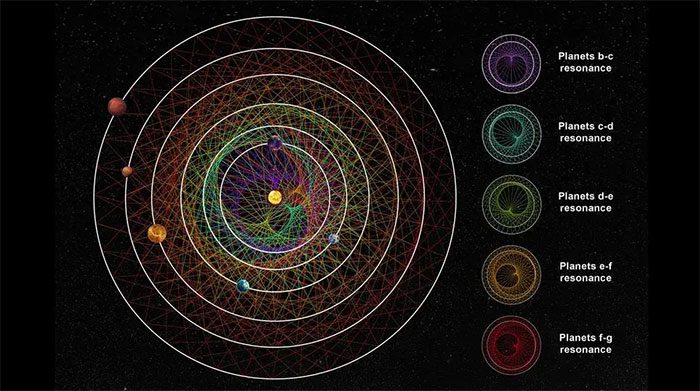Six exoplanets larger than Earth but smaller than Neptune have been in sync with each other since they formed around a star 4 billion years ago.
According to a publication in the journal Nature, these are the six planets of the HD 110067 star system. In this special “dance,” the outermost planet of the system completes one full orbit around its parent star exactly six times for each orbit of the innermost planet.
The other four planets maintain a harmonious orbital ratio with each other and the two aforementioned planets, creating a “perfect waltz” that could be considered the most unique in the universe.

Unique orbit of the HD 110067 planet system – (Graphic: Hibaut Roger, NCCR Planets)
The planet closest to the parent star completes its orbit in 9.1 Earth days, while the subsequent planets have orbital periods of 13.6, 20.5, 30.8, 41, and 54.7 days. Thus, the resonance ratios between neighboring pairs in the system are 3:2, 3:2, 3:2, 4:3, and 4:3.
“The HD 110067 system is remarkable for several reasons. First, all six planets have orbits that resonate with each other, which is quite rare. Second, this star is very bright, the brightest among the stars known to have more than four transiting planets,” said co-author Hugh Osborn from the University of Bern (Switzerland) to Live Science.
The parent star HD 110067 is a yellow star located about 100 light-years away from Earth in the constellation of Hydra.
The six planets in this system have diameters between those of Earth and Neptune in our Solar System, categorizing them as “sub-Neptunes.”
Sub-Neptunes are common around other stars but do not exist in our Solar System, making this star system a promising target for scientists to explore how these planets form and why our Solar System lacks this type of planet.
Another important aspect that scientists intend to investigate in this unique star system is using the power of the James Webb Space Telescope to probe their atmospheres.
They hope this will help detect potential “signs of life” such as methane, which could indicate the presence of subsurface oceans—types of oceans that NASA believes may exist on some planets and moons in the Solar System, where life could potentially thrive.





















































